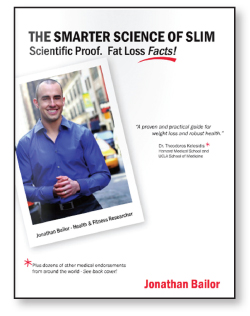 The Smarter Science of Slim by Jonathan Bailor is probably the best sensible-eating book I’ve ever read. Note that I didn’t say diet book, because there is no diet—it’s all about a healthful plan you can follow for the rest of your life, most of the time. Even Bailor acknowledges the need to indulge every so often.
The Smarter Science of Slim by Jonathan Bailor is probably the best sensible-eating book I’ve ever read. Note that I didn’t say diet book, because there is no diet—it’s all about a healthful plan you can follow for the rest of your life, most of the time. Even Bailor acknowledges the need to indulge every so often.
Of course, the reason I like this book so much is that Bailor’s nutrition findings are exactly what I believe. Here’s a quote that puts it into perspective:
“Myth: a calorie is a calorie. Researchers have discovered that calorie quality varies wildly. High-quality calories from nonstarchy vegetables, lean protein and natural fats trigger hormones that cause your body to burn fat. Low-quality calories from starches and sweets trigger hormones that cause the body to store fat.”
He backs that up with many studies, which he explains in understandable language. He’s very good at making the science easy to grasp—and the science of eating for fat loss is fairly simple. Here is Bailor’s list of high-quality foods: nonstarchy vegetables, seafood, lean meat, fat-free or lowfat cottage cheese, fat-free or lowfat plain Greek yogurt, fruit, eggs, nuts and seeds. He also recommends using whey-protein powder to ensure that you get enough quality amino acids.
It’s basically a body-building diet that will keep you lean and healthy and adding muscle, if that’s what you’re after. There are plenty of eye-opening graphs and charts showing how balancing protein, low-glycemic carbs and fat is the best way to eat and how the government’s diet guidelines have led us in the wrong direction and into an obesity epidemic.
One pie chart was especially startling. Precivilization diets, before rampant disease and obesity existed, consisted of 31 percent protein, 28 percent fat and 31 percent nonstarchy carbs—almost an equal balance. Today’s typical American diet is 51 percent carb—25 percent starchy, or high-glycemic, and 26 percent nonstarchy—34 percent fat and only 15 percent protein. A diet of high-glycemic carbs and low protein means spikes in fat storage and a good chance of obesity.
Bailor also provides some interesting ideas on resistance training with pure-negative reps at the core. It’s mostly for those who aren’t experienced trainees but good stuff nevertheless. It got me to incorporate some pure-negative sets into my workouts.
I can usually tell how much I like a book by the number of passages I highlight. My copy of this one now looks like it was printed on yellow paper. Seriously, this is a great book, a must-have for your library.




















You must be logged in to post a comment Login